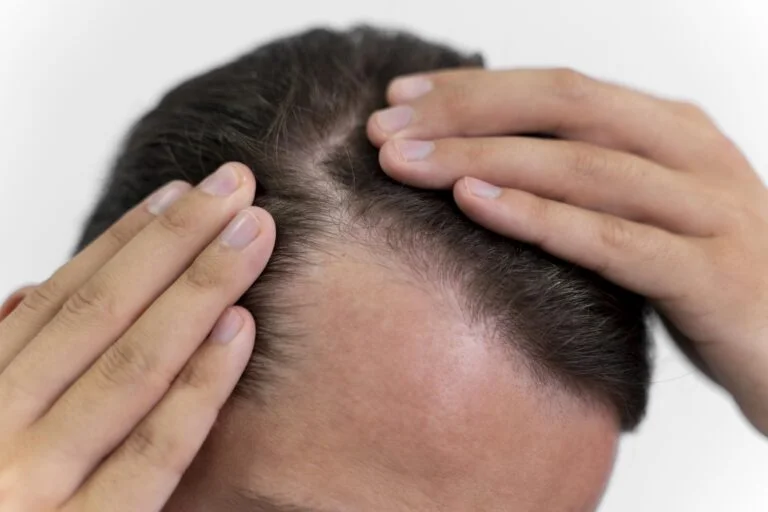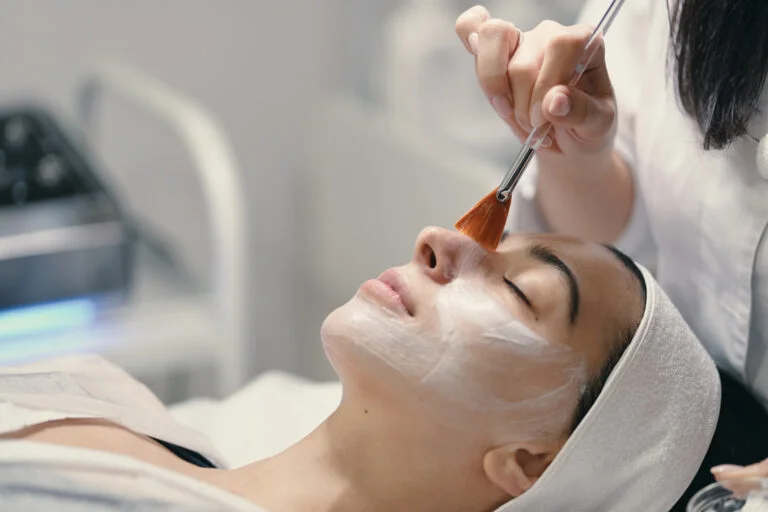Chemical skin peel treatments are a powerful option for addressing various skin concerns, including hyperpigmentation, acne scars, fine lines, and uneven texture. But when it comes to treating skin of color, specifically African American and other richly pigmented skin types (Asian Skin, Southeast Asian Skin, etc), it’s essential to approach chemical treatment for the face with care. Properly chosen and professionally applied, chemical peels can deliver impressive results without risking hyperpigmentation or irritation. This guide provides a comprehensive look at the benefits, safety tips, and recommended chemical peels for skin of color.
Understanding Chemical Peels
A chemical peel involves applying a specialized acid solution to the skin to exfoliate its upper layers, revealing smoother, brighter skin beneath. The types of acids and their concentrations vary based on the peel’s depth:
- Superficial Peels: Using mild acids like alpha hydroxy acids (AHAs) and beta hydroxy acids (BHAs), these peels gently exfoliate and are safe for most skin types, including darker skin.
- Medium Peels: These typically use trichloroacetic acid (TCA) and penetrate deeper than superficial peels, treating more significant pigmentation and texture issues.
- Deep Peels: Phenol-based, these peels penetrate the deepest, but they’re generally not recommended for skin of color due to the high risk of pigmentation changes.
Benefits of Chemical Peels for Skin of Color
For African American skin and other skin types rich in melanin, chemical peels for skin of color can offer a range of benefits:
- Even Skin Tone: Chemical skin peel treatment helps lighten dark spots, improving pigmentation issues common in melanin-rich skin.
- Acne Control: Peels with salicylic acid can unclog pores, reduce acne, and minimize future breakouts.
- Texture: By removing dead skin cells, peels reveal smoother, softer skin.
- Youthful Glow: By promoting cell turnover, chemical peel treatment for the face can rejuvenate the skin, giving it a fresher, more radiant appearance.
Choosing the Right Chemical Peel for Skin of Color
Selecting the right type and depth of chemical peels for skin of color is key to achieving effective results safely. Here are some peels that are generally safe for African American skin:
- Glycolic Acid Peels: Derived from sugar cane, glycolic acid is an alpha hydroxy acid (AHA) that provides mild exfoliation. When used in low concentrations, glycolic acid can improve skin texture and radiance without causing irritation. This peel is effective in treating fine lines, dullness, and uneven skin tone.
- Lactic Acid Peels: Another AHA, lactic acid is gentler than glycolic acid, making it an excellent choice for sensitive skin. Derived from milk, lactic acid peels brighten the skin and treat minor pigmentation issues.
- Salicylic Acid Peels: Salicylic acid, a beta hydroxy acid (BHA), is oil-soluble and penetrates deeply into the pores. This makes it ideal for acne-prone skin, as it helps to clear out pores, reduce inflammation, and prevent future breakouts.
- Mandelic Acid Peels: Mandelic acid is derived from bitter almonds and is one of the gentlest AHAs available. Being a chemical peel for hyperpigmentation, its larger molecular size penetrates the skin more slowly, reducing the risk of irritation. It’s effective for treating acne and hyperpigmentation, which makes it an excellent option for melanin-rich skin.
Precautions for Chemical Peels on African American Skin
While chemical peels can be transformative, they carry certain risks, especially for melanin-rich skin. Here’s how to maximize skin peel treatment safety:
- Choose a Skilled Practitioner: Working with an experienced dermatologist or licensed aesthetician familiar with chemical peels for skin of color is essential to reduce risks.
- Patch Test First: Always perform a patch test to ensure your skin responds well to the selected peel.
- Avoid Strong Peels: Deep peels, such as phenol peels, carry a higher risk of post-inflammatory hyperpigmentation (PIH) in darker skin tones. Opt for superficial or medium peels instead.
- Prep Your Skin: Prepare your skin by following a pre-treatment routine recommended by your chemical skin peel treatment provider (Chapel Hill). This may include using mild retinoids or brightening agents to minimize the risk of pigmentation issues.
- Sun Protection: After a chemical peel treatment for the face, melanin-rich skin is especially vulnerable to UV damage. Regular use of a broad-spectrum SPF 30 or higher is essential.
What to Expect During and After a Chemical Peel?
Understanding the process of chemical peels for skin of color helps you manage your expectations and results:
- During Treatment: The peel solution is applied for a specific time before being neutralized. You may feel a tingling or mild stinging sensation.
- Immediate Aftercare: After the skin peel treatment, your skin may be slightly red, tight, or sensitive, especially for medium-depth peels. Superficial peels usually result in minimal downtime, while medium peels may cause slight flaking for a few days.
- Peeling Process: Within a few days, the treated skin may begin to peel or flake, depending on the peel’s depth. Avoid picking or peeling the skin, as this can lead to scarring or hyperpigmentation.
- Long-Term Aftercare: Avoid active ingredients like retinoids or exfoliants for a week post-peel chemical treatment for the face. Apply soothing moisturizers and a high-SPF sunscreen daily to protect and nourish the skin as it heals.
Managing Hyperpigmentation Risk
Hyperpigmentation, a common concern for skin of color, can occur if a peel is too strong or the skin isn’t adequately protected after treatment. Here’s how to manage this risk using chemical peels for hyperpigmentation:
- Use Brightening Ingredients: After the peeling period, ingredients like vitamin C, kojic acid, and niacinamide can help prevent dark spots.
- Follow a Professional’s Instructions: An experienced skin peel treatment practitioner in Chapel Hill will customize the treatment strength and frequency to minimize pigmentation issues.
- Monitor Skin’s Response: If you notice unusual pigmentation changes, consult your provider immediately.
Benefits of Chemical Peels for African American Skin
When performed correctly, chemical skin peel treatments offer a variety of benefits for skin of color:
- Brightens Skin Tone: Peels can reduce hyperpigmentation and dark spots, evening out the complexion and revealing a brighter, more radiant skin tone.
- Improves Texture: By removing dead skin cells, peels smoothen skin texture, creating a soft, refined feel.
- Reduces Acne and Acne Scars: Peels like salicylic acid and mandelic acid can reduce acne breakouts and fade post-acne marks.
- Boosts Collagen Production: Some peels stimulate collagen, which can improve skin firmness and reduce fine lines over time.
Choosing a Reputable Provider for Chemical Peels
For skin of color, it’s crucial to work with a provider who understands the unique needs of melanin-rich skin. If you live in Raleigh, Durham, or Chapel Hill you have access to Dr. Stefan C Weiss, MD an internationally renowned board-certified cosmetic dermatologist with over 25 years of experience providing the best facial rejuvenation techniques, including chemical peels for patients worldwide.
At the same time, there is an increasing number of medical spas that offer chemical peels. The risk of experiencing unwanted and adverse side effects increases exponentially when unqualified or inexperienced practitioners perform a chemical peel treatment on skin of color. Although it may be at a lower price to have a treatment in a community setting, chemical peels can be dangerous on skin of color if not done properly. It’s best to have your chemical peel treatment for your face provided under the supervision of a board-certified dermatologist in a medical setting. They will make sure that your procedure is performed using the proper techniques and with safe ingredients for skin of color.
Board-certified dermatologists like Dr. Weiss and the team at Trillium Clinic Dermatology and Med Spa in Chapel Hill have specialized experience in chemical peels for skin of color. You can discuss any concerns as their years of experience are familiar with several skin types similar to yours. Patients with skin of color, looking for a chemical peel in Chapel Hill, can request a consultation at Trillium Clinic Dermatology and Med Spa.
Are At-Home Peels Safe for Skin of Color?
While some over-the-counter chemical exfoliants are safe for darker skin tones, it’s best to avoid stronger at-home chemical peels for skin of color. Many at-home products contain lower acid concentrations, which may not deliver the desired results or may worsen pigmentation if used improperly. For more intensive treatments, a professional setting is generally safer and more effective.
Final Thoughts: Embracing Chemical Peels Safely
Chemical skin peel treatment can be a valuable tool for addressing skin concerns in African Americans and other richly pigmented skin types. The key is choosing the right type of peel, performing pre- and post-care, and working with a qualified professional. By following these guidelines, individuals with skin of color can experience the rejuvenating effects of chemical peels while minimizing risks and achieving a smooth, radiant complexion.
At Trillium Clinic Dermatology and Med Spa in Chapel Hill, Dr. Stefan Weiss uses the VIPeel to perform chemical peels in Chapel Hill on the skin of color patients. This treatment is optimized for treating fine lines, large pores, hyperpigmentation, acne scars, stretch marks, and uneven skin tone. More importantly, the VIPeel was designed specifically for patients with skin of color. Patients often require several chemical peels, each spaced 4-6 weeks apart, to achieve optimal results. Chemical Peels are designed to reverse sun damage and other signs of aging and provide a more youthful complexion.
With the right approach and care, chemical peel treatment for the face offers African American skin a pathway to enhanced texture, tone, and long-term skin health. Always prioritize safety, take precautions, and consult a professional for the best results tailored to your unique skin needs.
If you are thinking about a chemical peel and want to benefit from expert care for your skin, Trillium Clinic Dermatology, led by Brown University Professor, Dr. Stefan Weiss, is ready to help you. You can also book directly online here.








